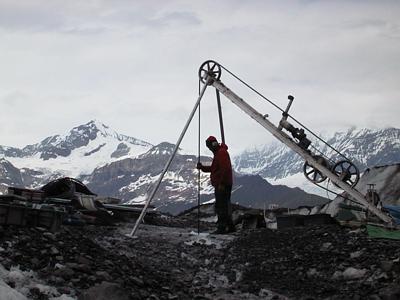3 July, 2000
July 3,
The drilling continued yesterday until 11:00 PM, and the achieved a depth of
150 meters. There is still at least 50 meters left to go to the glacier bed.
The drilling progress slowed significantly as the evening progressed. As
the hot water melts out a borehole, it also melts out any rocks and pebbles
that are lodged in the ice. This parcticular part of the glacier has a high
concentration of rocks and pebbles throughout most of its thickness. After
drilling to a depth of 100 meters a small pile of rocks has accumulated at
the bottom of the borehole. These rocks slow the melting capacity of the
drill and obstruct the advancing drill stem.
Today began by lowering the borehole video camera into the borehole to look
for englacial conduits. These are channels of water that extend downward
through the glacier to the drainage network beneath the glacier. They drain
water from the surface of the glacier. Their development and significance is
not very well known. We think that our borehole bisected one of these
features because at a certain depth the water that filled the hole dropped
(it dropped to about 20 meters). This means that it had to have drained
through a channel feature in the ice. This occurred at a drilling depth of
117 meters, so we were expecting to see a cavity opening at that point.
However, the water in the hole was quite turbid (had lots of fine sediment),
so viewing features was difficult. Visible evidence of an englacial conduit
was not observed.
Drilling continued in the same hole and only advanced an additional 10 meters
in the course of three hours. At a depth of 160 meters we abandoned the
hole. We calculated that up to 5 meters of rocks and sediment were piled on
the bottom of the hole.
The lake has exceeded the high water mark of last year. It continued to rise
at about 2 inches per hour for most of the day. The survey stakes have
nearly been placed. U.S. Geological Survey scientist Dennis Trabant has been
hard at work placing these stakes all over the glacier in the vicinity of the
lake. He will likely hike up to his survey post tomorrow to begin monitoring
the movement of the glacier surface.

Portland State University (PSU) glaciologist Andrew Fountain monitors the progress of the hot water drill at our first drill site on the ice dam.

Contact the TEA in the field at
.
If you cannot connect through your browser, copy the
TEA's e-mail address in the "To:" line of
your favorite e-mail package.
|
